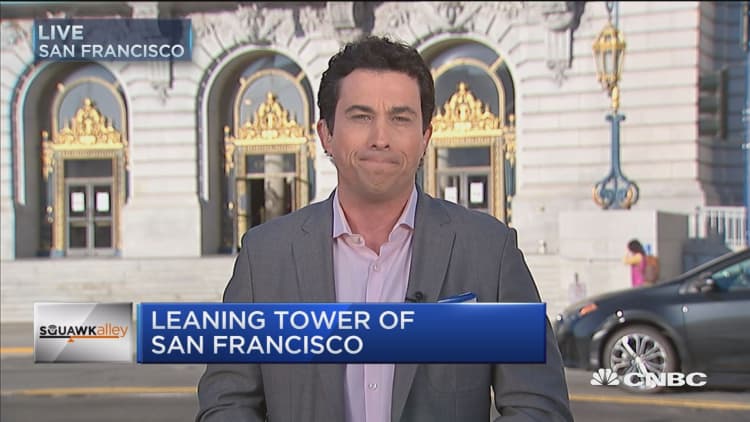
The Millennium Tower in San Francisco is a residential condominium that markets itself as rare and precious. Now two other adjectives also define this luxury high-rise: sinking and tilting.
Residents paid millions of dollars to live in the roughly 400-unit skyscraper. The building boasts an indoor pool, fitness center, wine cellar and private dining room. The tower has attracted Bay Area elites like NFL Hall of Fame quarterback Joe Montana; San Francisco Giants outfielder Hunter Pence; Tibco founder and Sacramento Kings owner Vivek Ranadive; and the late legendary venture capitalist Tom Perkins, who paid more than $9 million for the penthouse.
The tony tower is now attracting attention from a different group of powerful San Franciscans, however: the city's politicians, who want to understand why this 58-story building has sunk 16 inches, and is tilting at least 2 inches to the northwest since it was completed eight years ago.
Thursday, San Francisco city Supervisor Aaron Peskin will hold a hearing on the tower.
"We are in the midst of a huge building boom," Peskin tells CNBC. "We should make sure that we are building to the highest standards, and that we are building the safest buildings that we can in San Francisco, which is a seismically challenged part of the world."
There is disagreement about why the tower is sinking and tilting. The building's developer, Millennium Partners, blames the Transbay Joint Powers Authority, a public agency overseeing the construction of a new transit center for the city. The agency dug a 60-foot hole next to the tower, which the developer asserts caused the excessive sinking and tilting.
The TJPA contends that these claims are misplaced. Instead, it counters that the developer's poor structural design directly led to the tower's excessive settlement.
Specifically, the agency maintains that the foundation of the tower consists only of concrete slab supported by short piles that fail to reach the bedrock below, which it says cannot prevent settlement of a structure of this weight.
Rectifying the tower's problems remains difficult until the cause of the settlement is determined and agreed upon. Michael Lepech, an associate professor of civil and environmental engineering at Stanford University, offers two potential methods in which the current settlement could be theoretically remediated, or at least abated.
Lepech says that deep piles could be sunk or drilled under the tower, and the building shored by hydraulic jacking. Alternatively, stabilization chemicals or cement-based grout could be injected to bind the soil under the building. However, Lepech notes that both solutions are costly and unpredictable.
"These solutions will work, but it is not clear how challenging it would be," says Lepech. "Traditionally, these solutions are not designed for a building this size."
The building's developer says that the tower remains safe for residents as well as surrounding neighbors. Some real estate agents believe that the skyscraper could represent a compelling investment. They think the building's problems will be fixed eventually, and there is money to be made now for opportunistic buyers.
"A buyer can come in and offer under what sellers are asking," says Roh Habibi, principal at The Habibi Group, a broker in the San Francisco Bay Area. "If you're looking for a top building in a world-class city then the Millennium Tower is a great buy."
Still, the tower's troubles might soon extend beyond Thursday's hearing at City Hall, and into a courtroom. Four law firms recently filed a class-action suit representing the residents, seeking $500 million in damages from the developer, transit authority and other parties.


